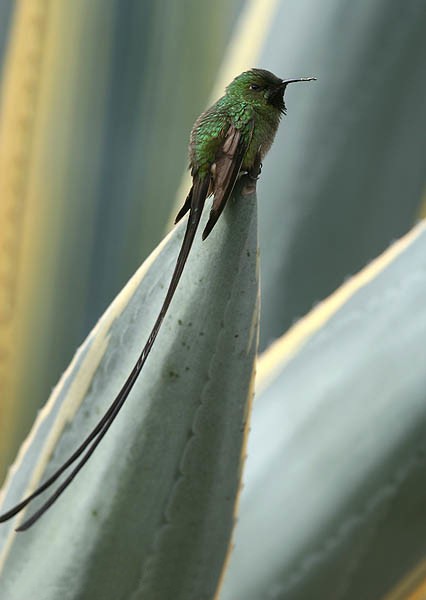Black-tailed Trainbearer
A species of Trainbearers Scientific name : Lesbia victoriae Genus : Trainbearers
Black-tailed Trainbearer, A species of Trainbearers
Botanical name: Lesbia victoriae
Genus: Trainbearers
Content
Description General Info
 Photo By Michael Woodruff , used under CC-BY-SA-2.0 /Cropped and compressed from original
Photo By Michael Woodruff , used under CC-BY-SA-2.0 /Cropped and compressed from original Description
Males measure between 21 and 24 centimeters long, including the long tail. They are mostly green, with long black tail feathers and an iridescent green patch on the chest and throat. Females are between 13.5 and 14.5 centimeters in length. They differ from the male in having a shorter tail and white underparts with green spots. The black-tailed trainbearer has a longer, more decurved bill and (in males) a longer, more curved tail than the green-tailed trainbearer, and also tends to be duller green overall. With a wing length of 59.9mm, Lesbia victoriae victoriae Is the largest subspecies in the genus Lesbia. 
Size
26 cm
Nest Placement
Shrub
Feeding Habits
Black-tailed Trainbearer primarily feeds on nectar and supplements its diet with small arthropods. It has a flexible foraging approach, utilizing flowers of different sizes and species, often close to the ground, and consumes more insects than its low-altitude counterparts.
Habitat
The black-tailed Trainbearer thrives in semi-open areas along the slopes of the central and northern Andes, typically at elevations ranging from 2500 to 4000 meters. Its preferred environments include forest edges, Polylepis woodlands, and sub-páramo to páramo regions punctuated with scattered bushes. The species exhibits adaptability and can inhabit urban ecosystems such as parks and gardens, which align with its preference for less dense vegetative spaces over closed forests.
Dite type
Nectivorous
General Info
Feeding Habits
Bird food type
Behavior
The black-tailed trainbearer is not aggressive and is commonly displaced by more aggressive species as the sparkling violetear (Colibri coruscans). 
Distribution Area
The black-tailed trainbearer is widely distributed in central and northern Andes from Colombia through Ecuador to Peru, at altitudes between 2500 and 3800 meters. Three subspecies are currently recognised. Lesbia victoriae victoriae is the northernmost subspecies, occurring from the central Andes of Colombia to southern Ecuador. L. v. juliae is found in the center of the species's distribution, from southern Ecuador to northern Peru. L. v. berlepschi is the southernmost subspecies, occurring from Huánuco to Cuzco in Peru. In the past, Ecuadorian populations of L. v. victoriae were sometimes treated as a fourth subspecies, L. v. aequatorialis, but they aren't different enough from Colombian birds to warrant treatment as a separate subspecies. Lesbia victoriae prefers semi-open areas instead of closed forest, meaning that it can adapt well to urban ecosystems like parks and gardens. 
Species Status
Because of its broad distribution and the size and stability of its populations, the black-tailed trainbearer has been evaluated as least concern by the IUCN. Its preference for open habitats makes this hummingbird relatively resilient to changes in urban and rural areas. 
Scientific Classification
Phylum
Chordates Class
Birds Order
Swifts and hummingbirds Family
Hummingbirds Genus
Trainbearers Species
Black-tailed Trainbearer